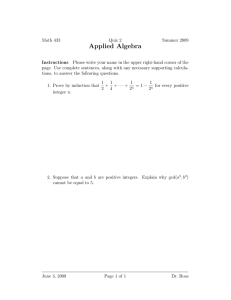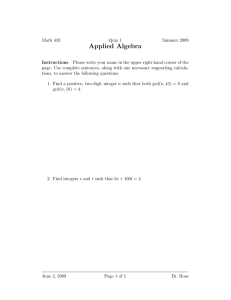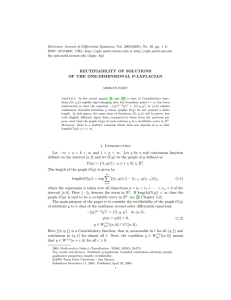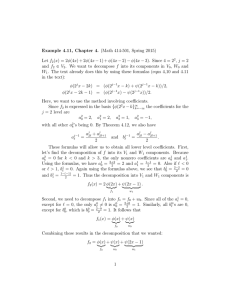GAPS IN THE SPECTRUM OF NATHANSON HEIGHTS OF PROJECTIVE POINTS Kevin O’Bryant
advertisement
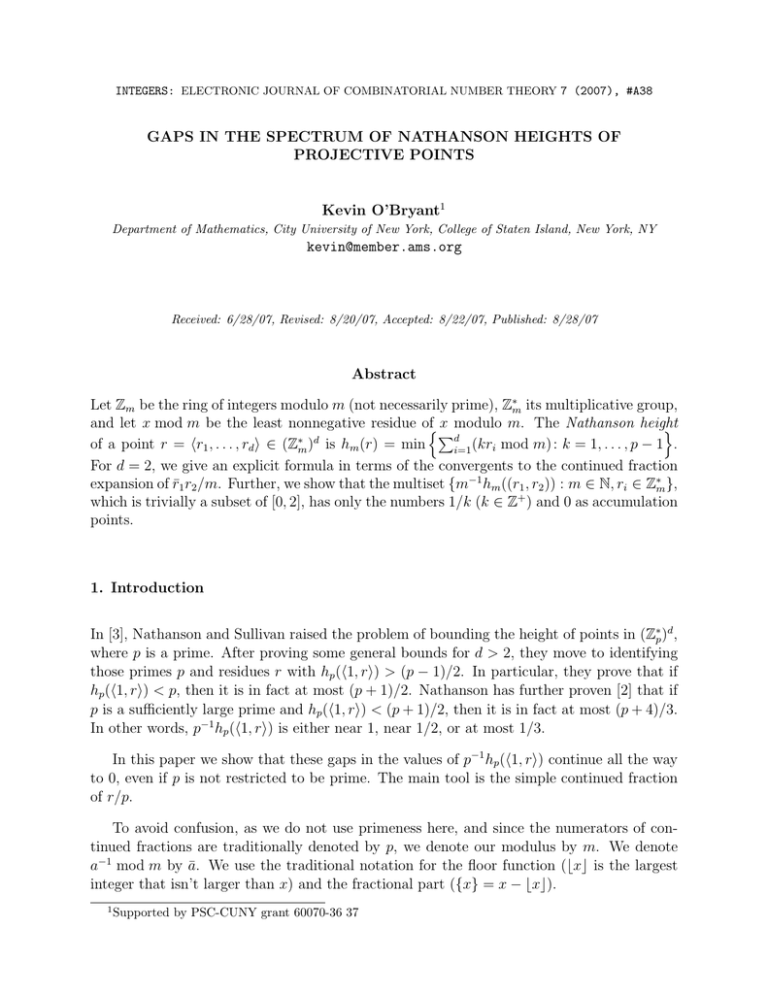
INTEGERS: ELECTRONIC JOURNAL OF COMBINATORIAL NUMBER THEORY 7 (2007), #A38
GAPS IN THE SPECTRUM OF NATHANSON HEIGHTS OF
PROJECTIVE POINTS
Kevin O’Bryant1
Department of Mathematics, City University of New York, College of Staten Island, New York, NY
kevin@member.ams.org
Received: 6/28/07, Revised: 8/20/07, Accepted: 8/22/07, Published: 8/28/07
Abstract
Let Zm be the ring of integers modulo m (not necessarily prime), Z∗m its multiplicative group,
and let x mod m be the least nonnegative residue of! x modulo m. The Nathanson height
#
"d
of a point r = !r1 , . . . , rd " ∈ (Z∗m )d is hm (r) = min
(kr
mod
m)
:
k
=
1,
.
.
.
,
p
−
1
.
i
i=1
For d = 2, we give an explicit formula in terms of the convergents to the continued fraction
expansion of r̄1 r2 /m. Further, we show that the multiset {m−1 hm ((r1 , r2 )) : m ∈ N, ri ∈ Z∗m },
which is trivially a subset of [0, 2], has only the numbers 1/k (k ∈ Z+ ) and 0 as accumulation
points.
1. Introduction
In [3], Nathanson and Sullivan raised the problem of bounding the height of points in (Z∗p )d ,
where p is a prime. After proving some general bounds for d > 2, they move to identifying
those primes p and residues r with hp (!1, r") > (p − 1)/2. In particular, they prove that if
hp (!1, r") < p, then it is in fact at most (p + 1)/2. Nathanson has further proven [2] that if
p is a sufficiently large prime and hp (!1, r") < (p + 1)/2, then it is in fact at most (p + 4)/3.
In other words, p−1 hp (!1, r") is either near 1, near 1/2, or at most 1/3.
In this paper we show that these gaps in the values of p−1 hp (!1, r") continue all the way
to 0, even if p is not restricted to be prime. The main tool is the simple continued fraction
of r/p.
To avoid confusion, as we do not use primeness here, and since the numerators of continued fractions are traditionally denoted by p, we denote our modulus by m. We denote
a−1 mod m by ā. We use the traditional notation for the floor function (%x& is the largest
integer that isn’t larger than x) and the fractional part ({x} = x − %x&).
1
Supported by PSC-CUNY grant 60070-36 37
INTEGERS: ELECTRONIC JOURNAL OF COMBINATORIAL NUMBER THEORY 7 (2007), #A38
2
1
1/2
1/3
1/4
1/5
1/6
1/8
0
0
1
12
1 1
6 5
1
4
1
3
2
5
1
2
3
5
2
3
3
4
4 5
5 6
11
12
1
Figure 1: The points ( mr , H( mr )), for all 0 < r < m ≤ 200.
If gcd(r1 , m) = 1, then hm (!r1 , r2 ") = hm (!1, r̄1 r2 "), and so we may assume without
loss of generality that r1 = 1. We are thus justified in making the following definition for
relatively prime positive integers r, m:
H(r/m) := m−1 · hm (!1, r")
= m−1 · min{k + (kr mod m) : 1 ≤ k < m}
$
$ %
%
k
kr
= min
+
:1≤k<m .
m
m
Figure 1 shows the points ( mr , H( mr )) for all r, m ≤ 200.
The spectrum of a set M ⊆ N, written Spec(M ), is the set of real numbers ß with the
property that there are mi ∈ M , mi → ∞, and a sequence ri with gcd(ri , mi ) = 1, and
H(ri /mi ) → ß. Nathanson [2] and Nathanson and Sullivan [3] proved that
$
%
1
1 1
Spec(primes) ∩ [ , ∞) =
, ,1 .
3
3 2
Our main theorem concerns the spectrum of Nathanson heights, and applies to both N
and to the set of primes.
Theorem 1.1. Let M ⊆ Z+ . If {m ∈ M : gcd(m, n) = 1} is infinite for every positive
integer n, then
$
%
1
+
Spec(M ) = {0} ∪
:k∈Z
.
k
INTEGERS: ELECTRONIC JOURNAL OF COMBINATORIAL NUMBER THEORY 7 (2007), #A38
3
2. Continued Fractions
For a rational number 0 < r/m < 1, let [0; a1 , a2 , . . . , an ] be (either one of) its simple
continued fraction expansion, and let pk /qk be the k-th convergent. In particular
p0
0
=
q0
1
p2
a2
=
q2
1 + a1 a2
p4
a2 + a4 + a2 a3 a4
=
q4
1 + a1 a2 + a1 a4 + a3 a4 + a1 a2 a3 a4
The qi satisfy the recurrence q−2 = 1, q−1 = 0, qn = an qn−1 + qn−2 (with a0 = 0), and are
called the continuants. The intermediants are the numbers αqn−1 + qn−2 , where α is an
integer with 1 ≤ α ≤ an .
Let E[a0 , a1 , . . . , an ] be the denominator [a0 ; a1 , . . . , an ], considered as a polynomial in
a0 , . . . , an , and set E[ ] = 1. Then pk = E[a0 , . . . , ak ] and qk = E[a1 , . . . , ak ]. We will make
use of the following combinatorial identities, which are in [4, Chapter 13], with 0 < s < t < n:
q! = qk E[ak+1 , . . . , a! ] + qk−1 E[ak+2 , . . . , a! ],
pn E[as , . . . , at ] − pt E[as , . . . , an ] = (−1)t−s+1 E[a0 , . . . as−2 ]E[at+2 , . . . , an ].
The following lemmas are well known. The first is a special case of the “best approximations theorem” [1, Theorems 154 and 182], and the second is an application of [1, Theorem
150], the identity pn qn−1 − pn−1 qn = (−1)n−1 . The third and fourth lemmas follow from the
identities for E given above.
Lemma 2.1. Fix a real number x = [0; a1 , a2 , . . . ], and suppose that the positive integer "
has the property that {"x} ≤ {kx} for all positive integers k ≤ ". Then there are nonnegative
integers n, α ≤ an such that " = αq2n−1 + q2n−2 .
Lemma 2.2. Let
p2k
= [0; a1 , a2 . . . , a2k ], and let x = [0; a1 , a2 . . . , a2k−1 , a2k + 1]. Then
q2k
q2k · x − p2k =
1
.
2q2k + q2k−1
We will use Fibonacci numbers, although the only property we will make use of is that
they tend to infinity: F1 = 1, F2 = 2, and Fn = Fn−1 + Fn−2 .
Lemma 2.3. For all k ≥ 1, we have qk ≥ Fk . Further, for " > k, we have
q! > qk F!−k ,
and
q! > a! qk .
INTEGERS: ELECTRONIC JOURNAL OF COMBINATORIAL NUMBER THEORY 7 (2007), #A38
4
Lemma 2.4. For 0 < 2k + 2 ≤ n, we have
q2k pn − p2k qn = E[a2k+2 , . . . , an ].
Moreover, if 2k + 2 = n + 1, then q2k pn − p2k qn = 1.
We now state and prove our formula for heights.
r
Theorem 2.5. Let
= [0; a1 , a2 , . . . , an ] (with gcd(r, m) = 1). Then
m
& r+1
'
r
H( ) = min
q2k
− p2k .
0≤k<n/2
m
m
Proof. First, recall that
H(r/m) = min {k/m + {kr/m} : 1 ≤ k < m} .
Set
I := {αq2i−1 + q2i−2 : 0 ≤ α ≤ a2i , 0 ≤ i ≤ n/2}.
We call " a best multiplier if
"/m + {"r/m} < k/m + {kr/m}
for all positive integers k < ". We begin by proving by induction that the set of best
multipliers is contained in the set I. Certainly 1 is a best multiplier and also 1 = 0·q−1 +q−2 ∈
I. Our induction hypothesis is that the best multipliers that are less than " are all contained
in I.
Suppose that " is a best multiplier: we know that
! r#
k ! r#
"
+ k
>
+ "
m
m
m
m
for all 1 ≤ k < ". Since k < ", we then know that {kr/m} > (" − k)/m + {"r/m} > {"r/m}.
Lemma 2.1 now tells us that " ∈ I. This confirms the induction hypothesis, and establishes
that
H(r/m) = min{k/m + {kr/m} : k ∈ I}.
(1)
Now, note that the function fi defined by
xq2i−1 + q2i−2 !
r#
fi (x) :=
+ (xq2i−1 + q2i−2 )
m
m
is monotone on the domain 0 ≤ x ≤ a2i . As 0q2i−1 + q2i−2 = q2i−2 and a2i q2i−1 + q2i−2 = q2i ,
this means that the minimum in Eq. (1) can only occur at q2i , with 0 ≤ 2i ≤ n.
As a final observation, we note that q0 /m + {q0 r/m} = (r + 1)/m is at most as large as
qn /m + {qn r/m} = 1 (as qn = m). Thus, the minimum in Eq. (1) cannot occur exclusively
at k = qn = m.
!
INTEGERS: ELECTRONIC JOURNAL OF COMBINATORIAL NUMBER THEORY 7 (2007), #A38
Corollary 2.6. Let 0 < r < m, with gcd(r, m) = 1, and let
For all k ∈ (0, n/2),
r
q2k
1
H( ) ≤
+
.
m
m
2q2k
Proof. First, note that
Lemma 2.2),
r
m
r
m
5
= [0; a1 , . . . , an ], with an ≥ 2.
< [0; a1 , a2 , . . . , a2k−1 , a2k + 1]. Now, as a matter of algebra (using
(
)
r+1
1
q2k
1
q2k
− p2k ≤ q2k [0; a1 , a2 , . . . , a2k + 1] +
− p2k =
+
m
m
m
2q2k + q2k−1
q2k
1
≤
+
.
m
2q2k
!
3. Proof of Theorem 1.1
First, we note that H(a2 /(1 + a1 a2 )) = (1 + a2 )/(1 + a1 a2 ) → 1/a1 , where a1 is fixed and
a2 → ∞. Thus, 1/k ∈ Spec(N) for every k. Also, H(1/a1 ) = 2/a1 → 0 as a1 → ∞,
so 0 ∈ Spec(N). The remainder of this section is devoted to proving that if ß > 0 is in
Spec(N), then ß is rational with numerator 1.
Fix a large integer s. Let r/m be a sequence (we will suppress the index) with gcd(r, m) =
1 and with H(r/m) → ß > F12s , where F2s is the 2s-th Fibonacci number.
Define a1 , a2 , . . . by
r
= [0; a1 , a2 , . . . , an ],
m
and we again remind the reader that r/m is a sequence, so that each of a1 , a2 , . . . , is a
sequence, and n is also a sequence. To ease the psychological burden of considering sequences
that might not even be defined for every index, we take this occasion to pass to a subsequence
of r/m that has n nondecreasing. Further, we also pass to a subsequence on which each of
the sequences ai is either constant or monotone increasing.
First, we show that n is bounded. Note that q2s /m (fixed s) is the same as q2s /qn , and by
Lemma 2.3 this is at most 1/(2F2s ), provided that n is large enough so that Fn−2s > 2F2s .
Take such an n. We have from Corollary 2.6 that
H(
r
q2s
1
1
1
1
)≤
+
<
+
<
< ß.
m
m
2q2s
2F2s 2F2s
F2s
This contradicts the hypothesis that H(r/m) → ß > 0, and proves that n must be small
enough so that Fn−2s > 2F2s .
INTEGERS: ELECTRONIC JOURNAL OF COMBINATORIAL NUMBER THEORY 7 (2007), #A38
6
Since m → ∞ but n is bounded, some ai must be unbounded. Let i be the least natural
number such that ai is unbounded.
First, we show that i is not odd. If i = 2k + 1, then
H(
r
r+1
) ≤ q2k
− p2k
m
m
and p2k and q2k are constant. Since a2k+1 → ∞, the ratio
r
p2k
→ [0; a1 , a2 , . . . , a2k ] =
.
m
q2k
Thus, since q2k /m ≤ 1/a2k+1 → 0,
H(
r
r+1
r
q2k
p2k
) ≤ q2k
− p2k = q2k +
− p2k → q2k
+ 0 − p2k = 0,
m
m
m
m
q2k
contradicting the hypothesis that ß > 0.
Now we show that there are not two ai ’s that are unbounded. Suppose that a2k and aj
are both unbounded, with j > 2k. Then
H(
Since a2k is unbounded,
1
2q2k
r
q2k
1
)≤
+
.
m
m
2q2k
→ 0. And since aj is also unbounded,
q2k
q2k
q2k qj−1
1
1
≤
<
·
<
·
→ 0.
m
qj
qj−1 qj
Fj−1−2k aj
Thus
q2k
1
+
→ 0.
m
2q2k
We have shown that there is exactly one ai that is unbounded, and that i is even.
We have
Now
r
m
= [0; a1 , . . . , a2k , . . . , an ], with all of the ai fixed except a2k , and a2k → ∞.
r+1
min q2j
− p2j
a2k →∞ 0≤j<n/2
m
(
)
q2j pn − p2j qn + q2j
= lim
min
a2k →∞ 0≤j<n/2
qn
(
)
E[a2j+2 , . . . , an ] + E[a1 , . . . , a2j ]
= min
lim
0≤j<n/2 a2k →∞
E[a1 , . . . , an ]
lim H(r/m) = lim
Using the general identity (for s ≤ " ≤ t)
E[as , . . . , at ] = a! E[as , . . . , a!−1 ]E[a!+1 , . . . , at ]+
E[as , . . . , a!−2 ]E[a! + 1, . . . , at ] + E[as , . . . , a!−1 ]E[a!+2 , . . . , at ]
INTEGERS: ELECTRONIC JOURNAL OF COMBINATORIAL NUMBER THEORY 7 (2007), #A38
7
with " = 2k, we can evaluate the limit as a2k → ∞. We arrive at
$
r
E[a2j+2 , . . . , a2k−1 ]E[a2k+1 , . . . , an ]
ß = lim H( ) = min min
,
0≤j<k E[a1 , . . . , a2k−1 ]E[a2k+1 , . . . , an ]
m
%
E[a1 , . . . , a2k−1 ]E[a2k+1 , . . . , a2j
min
k≤j<n/2 E[a1 , . . . , a2k−1 ]E[a2k+1 , . . . , an ]
$
%
E[a2j+2 , . . . , a2k−1 ]
E[a2k+1 , . . . , a2j
= min min
, min
0≤j<k E[a1 , . . . , a2k−1 ]
k≤j<n/2 E[a2k+1 , . . . , an ]
$
%
1
1
= min
,
.
E[a1 , . . . , a2k−1 ] E[a2k+1 , . . . , an ]
In either case, the numerator of ß is 1, and the proof of Theorem 1.1 is concluded.
We note that we have actually proved (with a small bit of additional algebra) a quantitative version of the Theorem.
Theorem 3.1. Let (ri , mi ) be a sequence of pairs of positive integers with gcd(ri , mi ) = 1,
mi → ∞ and lim sup H(ri /mi ) > 0. Then there is a pair of relatively prime positive integers
a, b, with a ≤ b, a positive integer c, and an increasing sequence i1 , i2 , . . . with
rij =
amij − c
b
and
H(
rij
1
)→
.
mij
max{c, b}
Conversely, if mi → ∞, and a ≤ b are two relatively prime positive integers, c is a positive
1
integer, and ri = ambi −c is an integer relatively prime to mi , then lim H(ri /mi ) → max{c,b}
.
In particular, if for every n there are arbitrarily large m ∈ M with gcd(m, n) = 1, then
Spec(M ) = Spec(N).
References
[1] G. H. Hardy and E. M. Wright, An introduction to the theory of numbers, 5th ed., The Clarendon Press
Oxford University Press, New York, 1979.
[2] Melvyn B. Nathanson, Heights on the finite projective line (2007), available at http://arxiv.org/math.
NT/0703646.
[3] Melvyn Nathanson and Blair Sullivan, Heights in finite projective space, and a problem on directed graphs
(2007), available at http://arxiv.org/math.NT/0703418.
[4] Joe Roberts, Elementary number theory—a problem oriented approach, MIT Press, Cambridge, Mass.,
1977.
